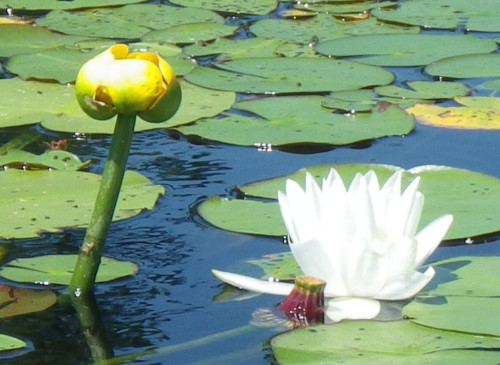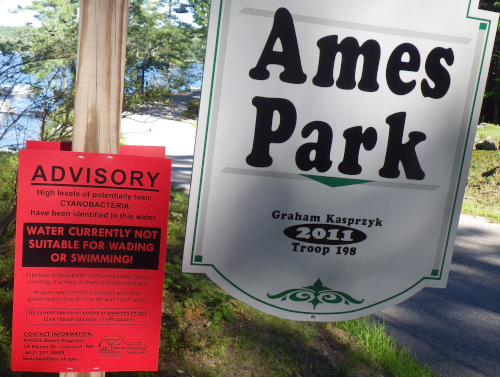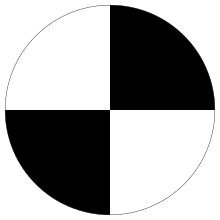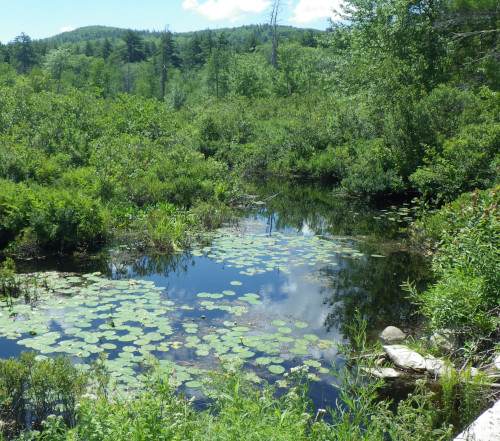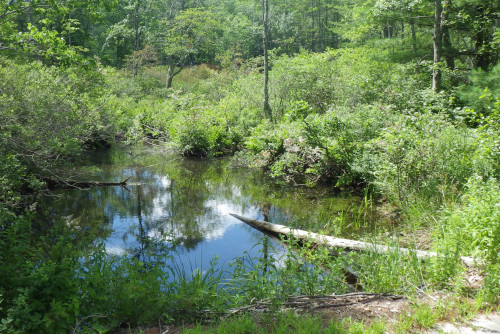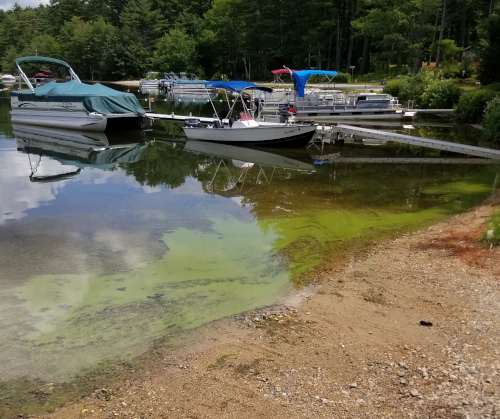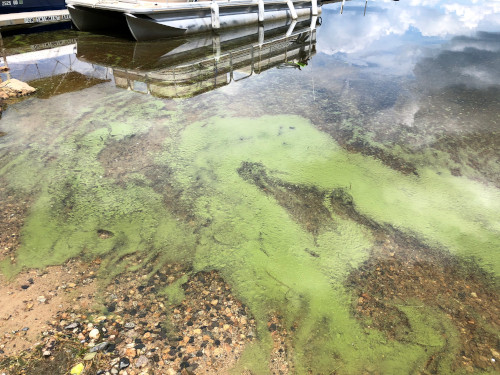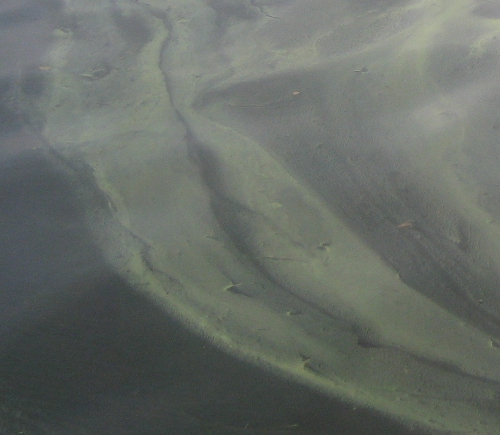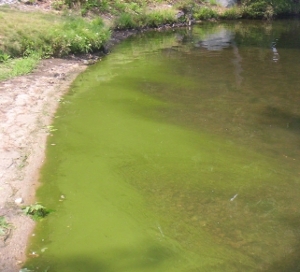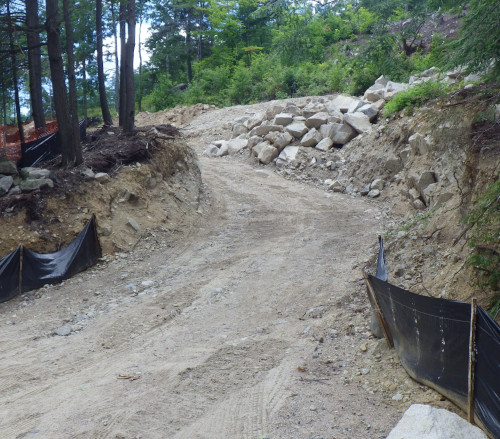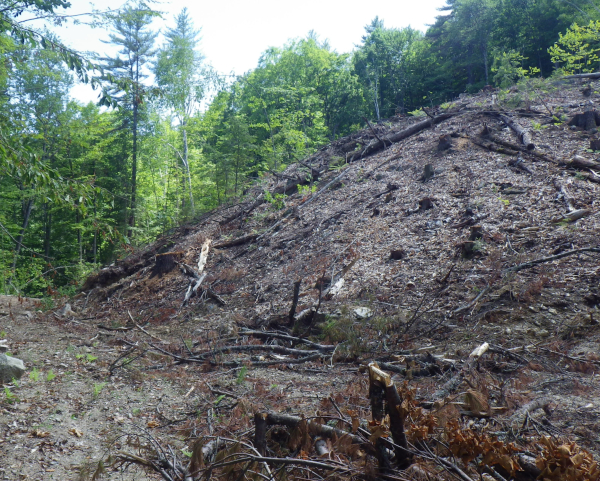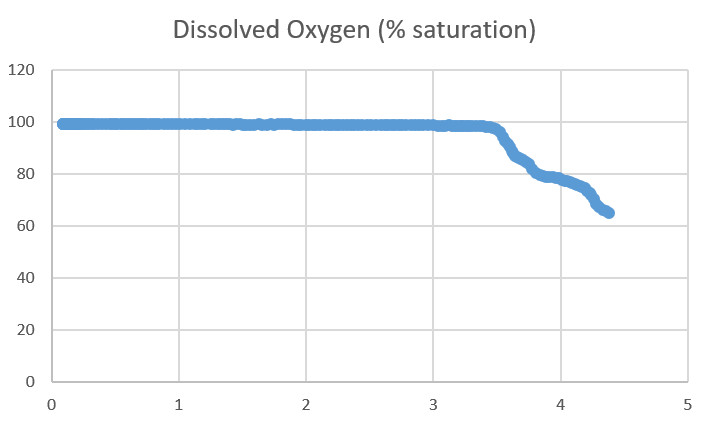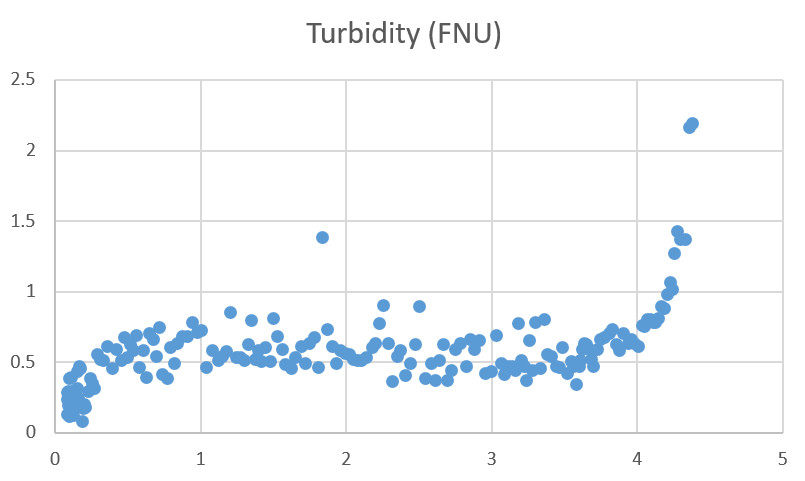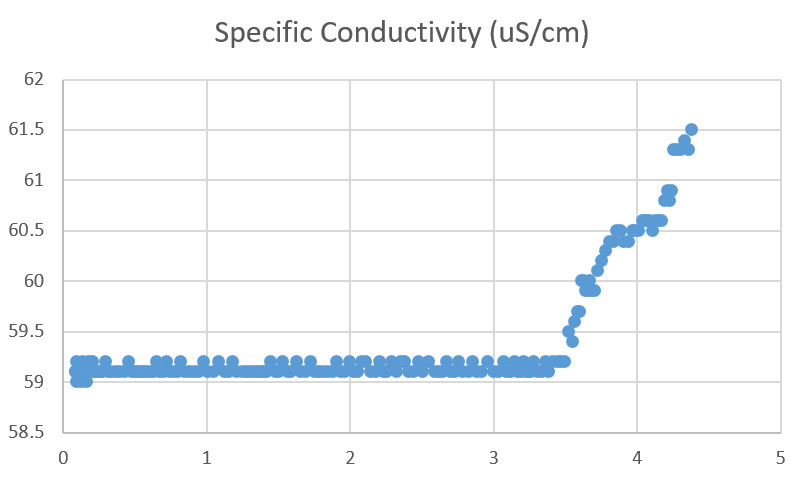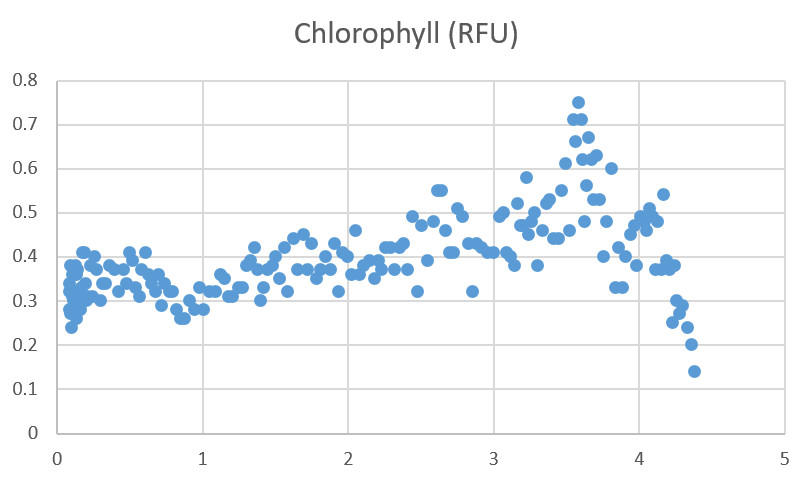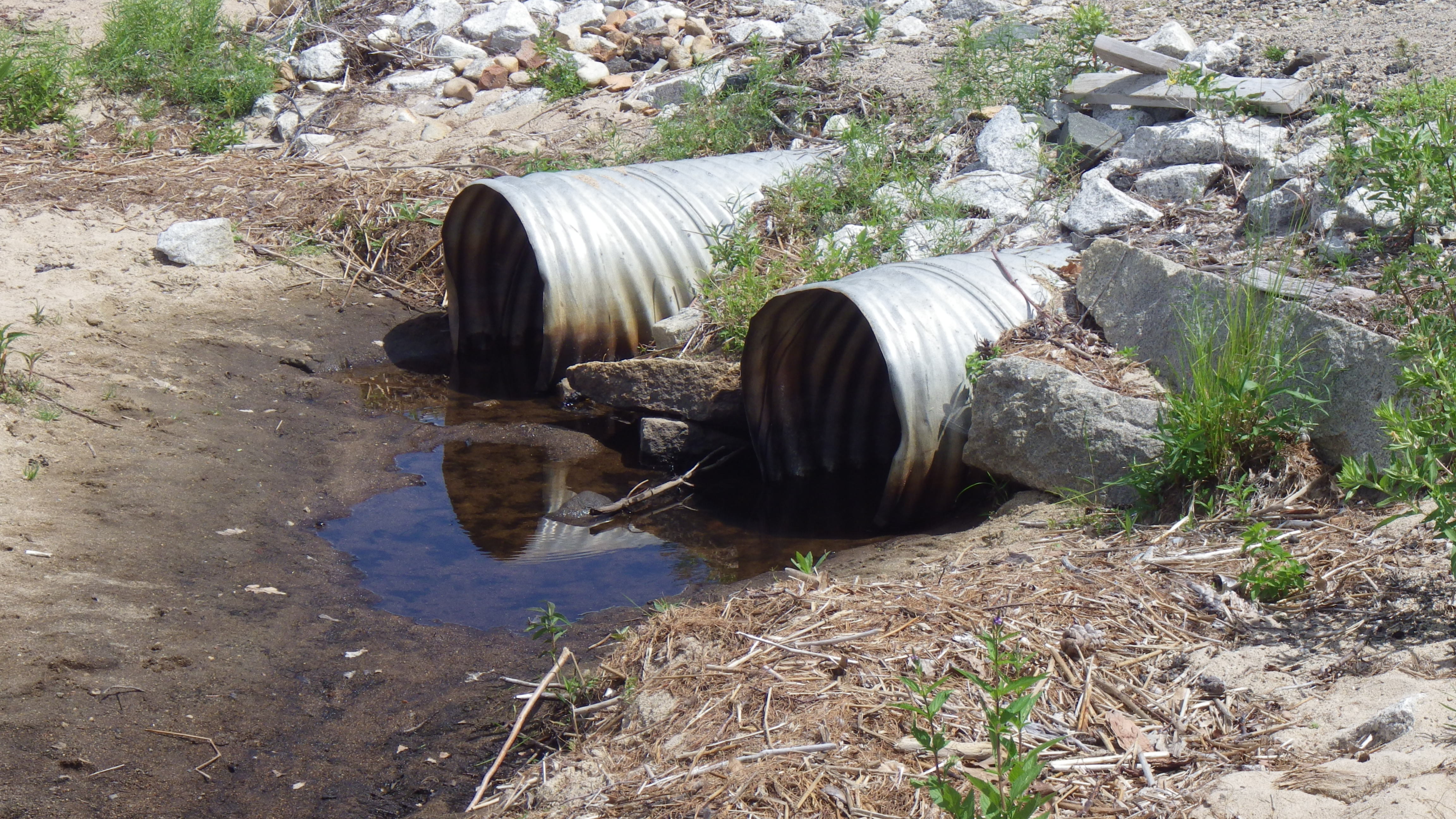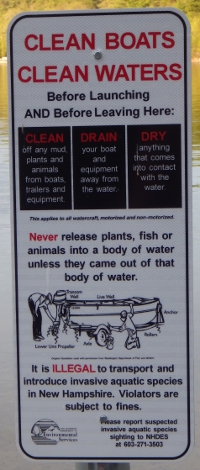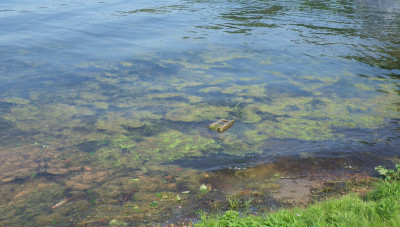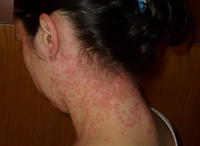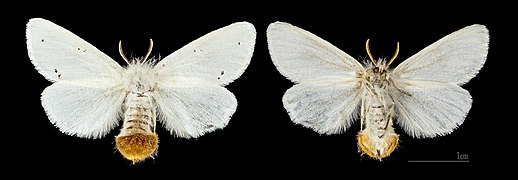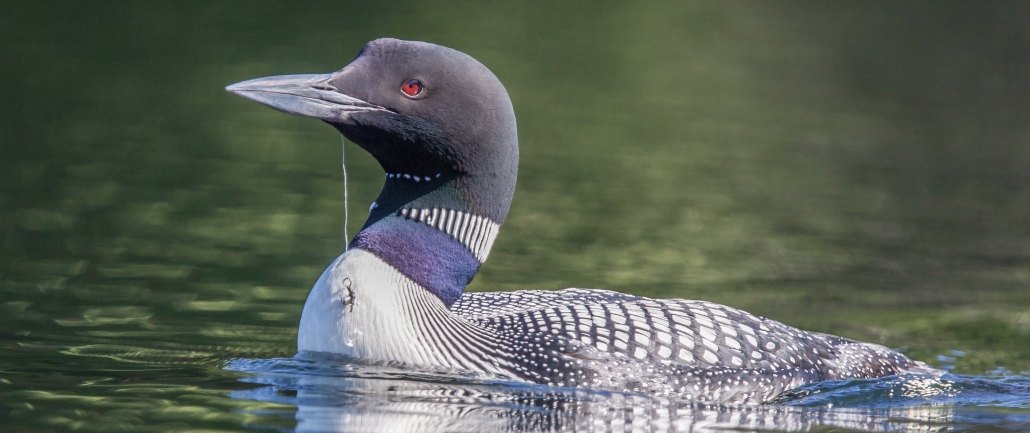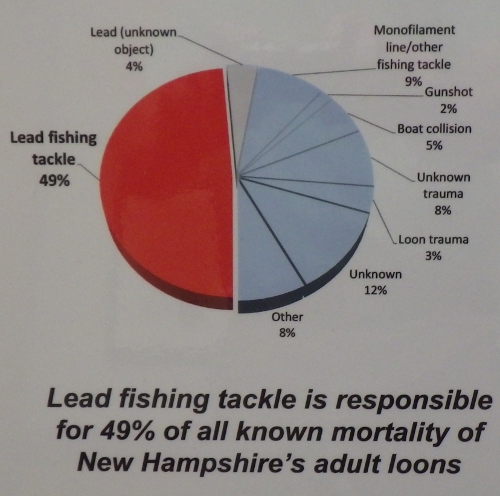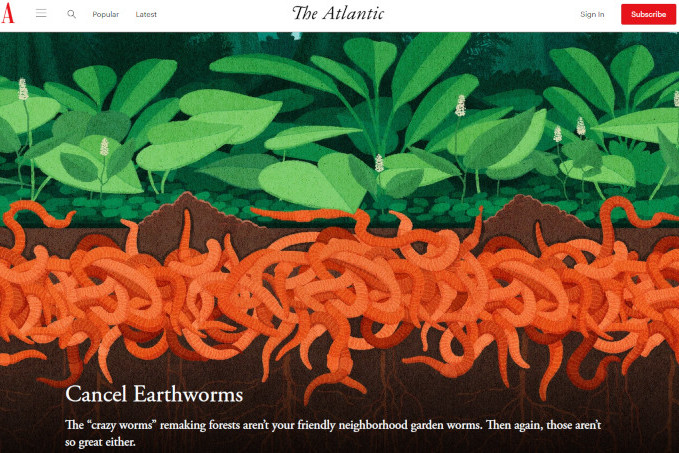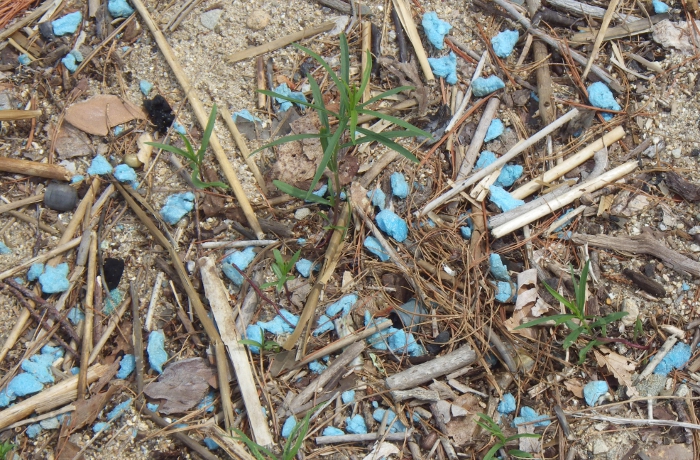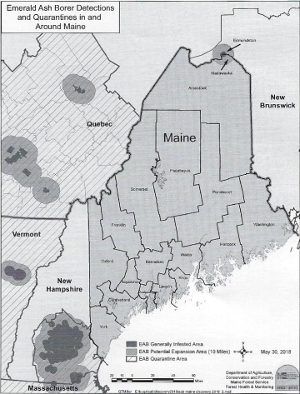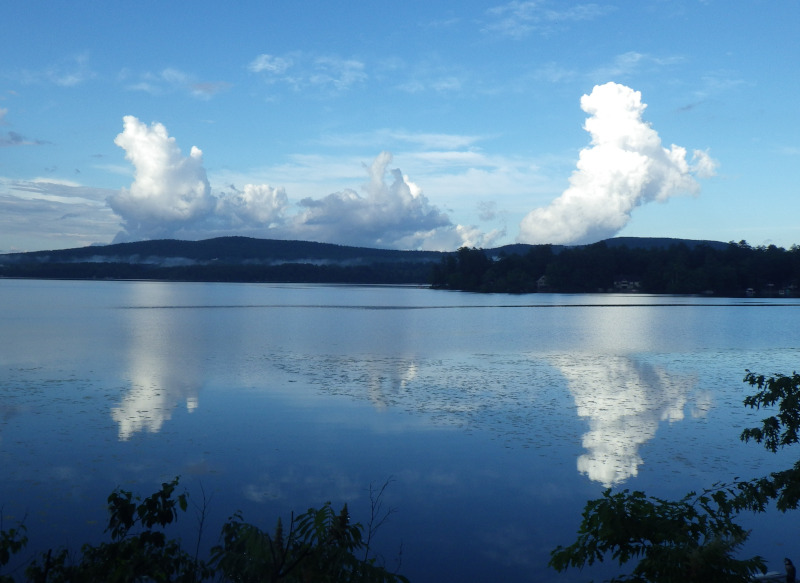Water Quality Monitoring of Province Lake
Effingham & Wakefield, New Hampshire, and Parsonsfield, Maine
2019 Report - Published Online on July 24, 2020
Revised May 21, 2021 [italics in square brackets]
Sponsored by:The Carriage House |
2019 was the 29th consecutive year of water quality monitoring conducted at Province Lake. The first 23 years of monitoring were conducted as part of the New Hampshire Volunteer Lake Assessment Program (VLAP). In 2014, the Province Lake Association (PLA) switched to the University of New Hampshire (UNH) Lakes Lay Monitoring Program (LLMP). While making this change had multiple benefits, the downside is that the 23-year continuous record of consistent analyses by VLAP has been broken, so data are not always comparable. See the 2015 report for details of the impact [, as specifically described by Sara Steiner, NH DES VLAP Coordinator].
The deep spot was sampled 5 times (June through late September) in 2019, the same number of times as in 2016 through 2018. The standard inlets and lake outlet were sampled 4 to 6 times (May through late September). Several other places were sampled 1 or 2 times primarily for phosphorus, presumably for a particular study.
I obtained the 2019 data for analysis directly from Bob Craycraft of UNH Cooperative Extension. Since they end up sending the data to NH Department of Environmental Services (DES) for their Environmental Monitoring Database (EMD), all data are therefore public information. In order to compare 2019 UNH results to prior years, only the June through early September data (summer season) were used in this report; this is consistent with all prior reports.
[The PLA partners with UNH LLMP and Bob Craycraft for the water quality work. PLA members assist in the coordination and collection of water samples, including providing boats to access the lake site. PLA membership dues finance the water sampling and lab analysis. Without PLA member support, this work would not be possible.]
Many of the terms in this report include hyperlinks to related web sites. By clicking on most of the underlined terms, you can access additional information. Clicking on most photos will get you a large photo with wider angle and higher resolution. To get back to the report from a photo, click the back arrow on your browser or [ALT]+[←] on your keyboard.
Use this menu to jump to a particular topic:
Overall Summary
- Water transparency was good at 2.60 meters, slightly less than the prior 7 years.
- Province Lake had a Lake Warning issued by DES for a cyanobacteriabloom July 25-31 last year. This was subsequent to having
a Lake Warning August 6-16, 2018, a bloom in late November, 2017, and no reportable cyanobacteria blooms in 2014 through 2016, after having had
them 4 years in a row (2010-2013).
WARNING: Since Province Lake has a history of cyanobacteria blooms of varying severity, it is advisable to have a look at the water each time you or your children plan to swim. We've been mostly lucky lately, but caution is always advisable. Since a cyanobacteria bloom is readily visible, if you don't see it, swimming is safe.
Two excellent sources of information about cyanobacteria are this DES web site and this DES Fact Sheet (updated in 2020). The DES web site is far more detailed. - Average phosphorus concentrations in the upper and lower layers of the lake decreased somewhat from 2018. Chlorophyll-a rose somewhat from 2018 to concentrations comparable to 2016 and 2017.
- The surface layers of the lake were close to neutral acidity, with pH's very close to 7.0, virtually the same as in 2018. This is good.
Details
This section provides a more detailed look at the UNH LLMP water quality data for Province Lake for June through early September 2019. Data from the excluded months is outside of the peak growing season, so is not typical.
1. Water transparency was an average of 2.60 meters (8.5 feet) in the deepest part of the lake, a decrease of 9 inches from the prior year (2018). Transparency is a measure of how deep you can see into the water, based on the visibility of a black-and-white Secchi disc that is slowly lowered into the water until it disappears, then raised until it reappears. The 2019 average transparency is somewhat less than the cluster of good transparencies we have had in the 7 years since 2012 that followed many years of mostly slowly degrading transparencies. It is still better than the 4 years before 2012. Please note that I am reporting the transparency that is measured without a viewscope because it represents how most people actually observe the lake. The viewscope method represents how you would see the lake through a diving mask or swim goggles. For comparison, the average 2019 viewscope transparency was 3.25 meters (10.7 feet), a decrease of only 2 inches from 2018. The statewide median transparency is 3.2 meters (10.5 feet), without a viewscope. We have a shallow lake, so sediments are easily stirred up, therefore we expect it to be below the state average. The deepest part of the lake is only 16 feet (4.8 meters) deep, variable with the lake level, as shown on the NH bathymetric chart.
2. Chlorophyll-a concentrations are used to indicate the average amount of algae (1) in the lake. The 2019 chlorophyll-a concentrations rose significantly to an average of 3.70 micrograms per liter (ug/L), a concentration that is nearly identical to the average concentrations of 2016 and 2017.
This places our 2019 average concentration at only 81% of the average amount that New Hampshire lakes had. Happily, Province Lake has been below the current NH median chlorophyll-a of 4.58 ug/L since 2005 and has only exceeded it 4 times in 29 years. A low level is good because dying algae forms the brown floating bottom masses in July and August. The algae masses settle loosely on the bottom when the lake is still and cloud the water when wind or boat wakes stir things up. This may be unsightly, but it is not harmful to anyone or their animals.3. Phosphorus is a nutrient required for photosynthesizing organism growth and is typically thought to be the nutrient whose availability most limits plant, algae, and cyanobacteria growth in NH lakes. In 2019, the average phosphorus levels in the upper water layer (sampled at 2.0 meters depth) recovered from a moderate spike in 2018 and returned to levels nearly identical to those in 2016 and 2017, slightly below the 29-year mean average, a 12% decrease from the prior year (2018). The 2019 level exceeds that in 50% of the lakes in NH, as it usually has.
The total phosphorus concentrations over the years have been high enough to earn Province Lake a "Marginal Impairment" listing in the "Aquatic life" use category, ever since NH DES started issuing listings of impairments for phosphorus and chlorophyll-a in 2010, as explained in 2013's Issue #5 of the Province Lake Water Newsletter.
In the lower water layer (sampled at 4.0 meters depth), the average phosphorus levels were 4% lower than the previous year, making them the 8th highest of the 19 years of data since those measurements started in the year 2000 (2003 was skipped.). During 2019, they were 13% higher than those measured at 2.0 meters.
The phosphorus concentration at the Rt. 153 Inlet (in NH, near the state line) continues to be elevated, with its 2019 level nearly identical to the previous year. That made this the 12th lowest in 29 years, so is still a good value. For reference, that is 75% above the average phosphorus concentration at the deep spot. As of the time of this posting, this inlet is well marked by the steel plates (photo) that have been installed to carry Rt. 153 over the replacement culvert. At risk of confusion, I'll mention that the Rt. 153 inlet is where the upper South River flows into Province Lake. The lower South River drains the lake under Bailey Road immediately after the "dam" that is controlled by the PLA.
The average phosphorus concentration measured at the Island Inlet on Bonnyman Road dropped 35% from 2018, making it the lowest in 29 years, nearly matching the concentration at the deep spot. This is great news! The reason is unknown to me, but perhaps someone replaced a leaking septic system. (Don't know, just a guess. If correct, we are grateful to whoever did it.) The inland side of the Island Inlet is shown here. The sample is taken where the water flows into the culvert to pass under Bonnyman Road.
Phosphorus clings to sediments, so soil erosion and sediment disturbance can increase phosphorus concentrations. Both inlet locations have had a history of elevated and fluctuating total phosphorus concentration. It would be more great news if the Island Inlet left its history of elevation behind - we'll find out next year!
It is important to educate lake users on the importance of operating jet skis and boats at slow speeds in shallow areas to minimize disturbance to sediments and vegetation. Hopefully, few if any wake-surfing boats will be showing up at Province Lake, as the environmental impacts could be problematic in our shallow water body. See the freshly issued NH Final Report of the Commission to Study Wake Boats for more on the subject. Churning up the bottom sediments releases phosphorus, which promotes plant, algae, and cyanobacteria growth; increases turbidity (scattering of light by suspended particles), and decreases clarity.
4. Chlorophyll-a versus Phosphorus: See last year's report for a statistical analysis of the relationship between Chlorophyll-a and Phosphorus.
5. We had never sampled Province Lake for nitrogen as part of VLAP, but it is now included in the new UNH Lakes Lay Monitoring Program. A 1987 DES Lake Assessment Program survey had concluded that plant and algae growth in Province Lake is actually limited by the amount of nitrogen, rather than by phosphorus. Now that nitrogen is being monitored, we have the potential to eventually learn if that is true. At least 10 years of data are required before a meaningful statistical analysis can be performed. Meanwhile, it is important to be sure nitrogen-containing fertilizers are not used near the shoreline, or streams or ditches feeding the lake, and to be sure septic systems are operating properly. It would also be a tiny help not to pee in the lake while swimming; each time adds about 40 milligrams of nitrogen to the water.
If you have a lush, bright green lawn, it could be a sign to your neighbors and the community that you are fertilizing your lawn, possibly making a significant contribution of nitrogen and/or phosphorus to the lake. On the other hand, if you pump water directly out of the lake to irrigate your lawn, you can contribute to improving the lake water quality by removing nutrients from the water and putting them to use on your lawn; I have been told that some people actually do this here.
6. Province Lake had a Lake Warning issued by DES for a cyanobacteria bloom July 25-31 last year (shown here). This was subsequent to having a Lake Warning August 6-16, 2018, a bloom in late November, 2017, and no reportable cyanobacteria blooms in 2014 through 2016, after having had them 4 years in a row (2010-2013). You may read the details of the 2019 Lake Warning in the press release issued by DES when it ended. These photos of the 2019 bloom were provided by the PLA in a warning email they sent to all members. Having timely access to such emails is a good reason to join the PLA.
Province Lake had experienced its first confirmed cyanobacteria bloom since the 1970's in September 2010, then had blooms 4 years in a row (2010-2013). Fortunately, no sightings worthy of a Lake Warning then occurred during 2014 through 2016. The blooms this decade mean we are susceptible to having them in future years. When a cyanobacteria bloom is in progress (see description below), there is no way for us to know if it is toxic or not, so we need to act as if it is toxic. Therefore, it is important to know what a bloom looks like and act accordingly. If a cyanobacteria bloom is suspected, there may be Facebook postings and/or email alerts issued.
What a Cyanobacteria Bloom Looks Like: Large concentrations of cyanobacteria (a bloom) would be seen as a green, blue, or pink surface scum in a section of the lake. This is different from the tan or yellowish foam seen sometimes after strong winds. If present in large amounts, cyanobacteria can be toxic to animals and humans. There is some evidence connecting it with increased risk of ALS. While recreational exposure to cyanobacteria toxins is a major concern of NH DES, there have been no documented cases of cyanotoxin-related illnesses in New Hampshire. Photo by NH DES, courtesy of the PLA, 2012.
If you think you are seeing a cyanobacteria bloom, stay out of the water and especially, keep your children and pets out of the water. Call the NH DES Cyanobacteria Hotline at (603) 848-8094 or email beaches@des.nh.gov to describe what you see. Then call the PLA's phone number, (207) 200-3243, so a sample can be promptly collected for potential NH DES analysis. See Item 2 of the Overall Summary above for links to more info. If suspicious, during "swim season" NH DES may sample and analyze the suspected bloom, then post a Lake Warning if there is any danger. They will monitor the situation and remove the postings when all is clear.
According to the DES web site, research indicates that cyanobacteria numbers increase as nutrients in the water increase. Therefore, the best ways to try to minimize cyanobacteria blooms are to eliminate fertilizer use on lawns, to keep the lake shore natural, to protect against shoreline erosion, and to properly maintain septic systems. These measures will only become more important as the pressure of human population growth results in more land being cleared and developed in the Province Lake watershed. The specific causes of our own blooms is unknown, but preventing future blooms is a major goal of the Watershed Management Plan.
7. A pH between 6.5 to 7.0 is ideal for fish, according to VLAP. pH is the measure of acidity, where 7.00 is neutral, below 7 is acidic, and above 7 is basic. Lab measurements averaged 7.16 in the upper layers and 6.94 in the lower layers. The state average in the upper layers is 6.6. The lake's pH was little changed from 2018, especially in the upper layers, therefore, the lake in 2019 was still close to being the least acidic it has been in 29 years.
The average lab-measured pH at the Rt. 153 inlet was 6.22, essentially equal to last year's pH of 6.21. The only years less acidic than 2018 and 2019 were the 3 years that immediately preceded them (2015-17), based on the lab analysis results. This inlet drains a large wetland, which naturally has a high concentration of tannic, humic, and fulvic acids from decomposition of plant life, which give it the color of tea and reduce its pH. No problem is indicated. The average pH at the Island Inlet was 6.54, very slightly less acidic than the prior year and the 7th least acidic in 29 years. Less acidic inflowing waters are good for the lake. This inlet also drains a wetland.Exceedances of the Water Quality Criteria for pH are defined as: pH < 6.5 or pH > 8.0. The state average pH of 6.6 is barely better than the 6.5 criterion, therefore a large number of New Hampshire water bodies are listed as "Slight impairment - marginal condition" in the "Aquatic life" use category for pH. Although our current pH is excellent, questions 4 and 4A of the 2012 supplemental report explain why Province Lake is listed as "Slight impairment - marginal condition" for pH and will probably stay listed for years. Despite the regulatory inertia that keeps this pH impairment listed, the fact that our surface layers were not acidic, but straddled neutrality (7.00) in 2018 indicate that this is one water quality parameter that we need not worry about at this time.
8. Province Lake was listed in 2008 as impaired for mercury in fish and it remains so with all other surface waters in New Hampshire (2). Two fish from Province Lake tested in 2009 were shown to have safe mercury levels, but just two fish cannot be assumed to be sufficiently representative of all fish in the lake, especially since 10 years have passed since those fish were caught. It's better to be cautious and do catch-and-release, which makes for better fishing anyway, not to mention leaving food for the loons and bald eagles.
9. Thanks to the UNH program, dissolved oxygen (DO) was measured 3 times last summer season and once in late September, rather than once every 2 years under the VLAP schedule. In 2019, averaging across all depths for the summer season, the DO was at 93% saturation in the deep part of the lake. This detail of DO data was never available under VLAP, so there is insufficient past data to compare it to in any statistically meaningful way, except to say that generally, DO levels in Province Lake have been satisfactory. A high oxygen level is a sign of the lake's overall good health. I encourage powered watercraft to operate fast far from the shore to mix the deep waters and boost the oxygen concentration, while minimizing their speed and use in the shallows.
10. Fun With Charts! An amazing item of equipment that UNH LLMP has brought to Province Lake is the YSI EXO2 Multi-Parameter Water Quality Sonde. What I know of it, I learned from the extremely detailed Excel spreadsheet of results from UNH. It was brought to the deep spot in Province Lake one time in 2019 on the morning of August 1. During its session, it was lowered into the lake at a rate of 0.9 inch every 3 seconds, taking 10 minutes and 41 seconds to reach the bottom, during which time the boat drifted 112 feet to the southeast (heading 134 degrees). At each of those 0.9 inch intervals, it recorded time, probe depth, temperature, dissolved oxygen, pH, oxidation reduction potential, specific conductivity, turbidity, chlorophyll, cyanobacteria, surface air pressure, latitude, and longitude. How is that for extreme detail?!!
Here I will provide you with charts of most of those parameters. Click on the charts to see them larger and easier to read. I will not go into too much detail, but one thing I found notable is the sudden inflection of data on most of the charts that occurs at a depth of about 3.5 meters (the bottom, X-axis of each graph.) The Secchi disc transparency depth on that trip was 3.4 meters without the viewscope. With the viewscope, they could see the Secchi disc resting on the bottom at a depth of 4.4 meters.
I interpret the inflection to indicate that the lake water is well mixed above 3.5 meters by wind and boat traffic. Below that boundary layer, due to lack of mixing, oxygen is depleted, with the resulting chemistry causing the water to be more acidic (lower pH). For whatever reason, that region of the lake also has more suspended and/or dissolved solids, leading to increased turbidity and conductivity, which accounts for the Secchi disc transparency depth corresponding to the boundary layer depth. I would venture to say that the blip up at the end of each of those graphs represents the disturbance of the sediments as the probe hit bottom.
The chlorophyll and cyanobacteria charts are given in units of RFU, which stands for "relative fluorescent units". Think of it as a measure of relative abundance, not an absolute measurement. I find it interesting that the chlorophyll level would be rising as the probe made its way down, peaking at the boundary layer, only really dropping off half a foot from the bottom. At the same time, cyanobacteria are randomly distributed across the entire water column, showing no correlation with chlorophyll, even though they contain chlorophyll.
Have fun pondering this most detailed snapshot I have ever seen of Province Lake!
11. Much E. coli bacteria testing was done in 2013 as part of the study for the Province Lake Watershed Management Plan (see the 2013 supplementary report). Despite some very localized problems with E. coli bacteria in 2013, no E. coli sampling has been performed since then. According to NH DES, if funding and interest exist for further E. coli testing, it can be arranged.
Even so, it only makes sense that everyone should still stay out of the stream that flows from the golf course and drains into Province Lake at the beach along Rt. 153 near Shore Acres Road in Maine, shown here during a dry period in July 2020. Click photo for wider angle. If you see that water is flowing into the lake at that location, it would be best to avoid swimming too close to it. Canada geese grazing the golf course are almost certainly the source of the E. coli measured in 2013, although that reason does not make the E. coli concentrations safe. Generally, it is probably best to avoid swimming in any streams as they flow into the lake, since even those with E. coli levels considered safe had measurable amounts of bacteria in 2013. Of course, it is always best to avoid swallowing lake water under any circumstances.
12. European water-starwort: Callitriche stagnalis, commonly known as either "pond water-starwort" or "European water-starwort", appeared in Province Lake during 2014 and got its first real attention in 2015. It is not native to North America and is ranked "1-Severely invasive" in the Maine Natural Areas Program Advisory List of Invasive Plants - 2019, although not yet in New Hampshire. Its dense weed bed is a threat to native plants that might otherwise grow in that spot, and is also an impediment to swimming in that area. Like any weed bed, it creates habitat for leeches, which occur naturally in New Hampshire lakes. Leeches require unpolluted water, so their presence is actually a good sign, just not a sign we like to live with. There is an extensive detailed report about the appearance of C. stagnalis in Province Lake published on this web site. The size of the weed bed was measured each May through 2018. In May 2019, the weed bed appeared to be being suppressed by the excessively high water in the lake, so measurements were not taken. Pandemic travel restrictions meant we were not here to measure the bed at the appropriate time in early May 2020. However, this photo taken on July 2, 2020, shows it is still there. NH DES has provided an approved control procedure, which is included in the report. In addition, DES provided specific permission by email in 2017 to the appropriate parties to apply that procedure.
Previously Addressed Bigger Environmental Issues for Province Lake and Its Environs
Browntail Moth
Invasive Browntail Moth caterpillars are a major problem in Coastal Maine this year, as they were last year, the first time I had heard of them. This is not just the typical problem of being bad for trees, but an actual human health issue of shed hairs causing respiratory distress or poison-ivy type rashes.
THIS ARTICLE, reprinted here by permission of Maine Woodland Owners Exec. Director Tom Doak, succinctly
gives the highlights of what you need to know. ![]() has an excellent monthly newsletter that I highly recommend. I checked again and the (866) phone number given therein does still work outside of Maine, but they still recommended
calling (866) 444-4211 if you are in New Hampshire. THIS ARTICLE has useful photos.
You can learn much more at the following web sites:
has an excellent monthly newsletter that I highly recommend. I checked again and the (866) phone number given therein does still work outside of Maine, but they still recommended
calling (866) 444-4211 if you are in New Hampshire. THIS ARTICLE has useful photos.
You can learn much more at the following web sites:
According to the Browntail Moth Risk Map, the "Alert" zone reaches right to the state line at Province Lake, but the caterpillar has not been found here yet. If you find these caterpillars here, the states want to know. You will want to get their advice before doing anything about an infestation, as any contact is hazardous.
Loons and Lead
Most birds swallow small stones to help them digest food. Many fishing sinkers fall into the size range that loons prefer. Being fish-eaters, loons have a lower stomach pH than waterfowl that eat vegetation, such as geese and most ducks. The lower pH more effectively dissolves the lead, which then kills the bird. Poisoning from ingestion of lead objects has been identified as the #1 cause of loon deaths in fresh water. Therefore, most lead fishing sinkers have been outlawed so, if you still own any lead fishing gear, please stop using it immediately. For definitive and up to date information on this subject, please see the Loon Preservation Committee's Loons and Lead web page. Read the Loon Center's full poster on the subject.
Earthworms
If you bring up or buy earthworms to use as bait, you absolutely should not release them on the ground, since they are not native (new link!) to New England and they can eat up the leaf litter and disturb the soil. Many native plants, such as lady slippers, require undisturbed soil to live. As mentioned in last year's report, according to an article in Northeastern Naturalist, earthworms can also increase the phosphorus available to be washed into the lake.
Here is an excellent new article dated January 2020 from The Atlantic about "global worming", the invasive earthworms you grew up with that you thought were good for your garden, and the "crazy worms" that are now on the march. The crazy ones appeared in my woods in Rhode Island last year and started wiping out the leaf litter. Here is an excerpt from the article:
"In the absence of worms, North American hardwood forests develop a thick blanket of duff - a mille-feuille of slowly decomposing leaves deposited over the course of years, if not decades. That layer creates a home for insects, amphibians, birds, and native flowers. But when worms show up, they devour the litter within the space of a few years. All the nutrients that have been stored up over time are released in one giant burst, too quickly for most plants to capture. And without cover, the invertebrate population in the soil collapses.
"Where millipedes and mites once proliferated, now there are only worms. 'If you were to think about the soil food web as the African savanna, it's like taking out all the animals and just putting in elephants-a ton of elephants,' Dobson says.
"With their food and shelter gone, salamanders suffer and nesting birds find themselves dangerously exposed. Plants like trillium, lady slipper, and Canada mayflower vanish, too. This may be because the worms disrupt the networks of symbiotic fungus that many native plants depend on, or because worms directly consume the plants' seeds. Or that native species, accustomed to spongy duff, are ill-prepared to root into the hard soil left behind when the worms have finished eating. It could be all of the above.
"Perhaps most worryingly, early studies suggest that worms can sometimes halt the regeneration of trees. Josef Görres, a soil scientist at the University of Vermont, says he often struggles to find a single seedling in invaded portions of New England's famous maple forests. His theory is that the worms take out all the understory plants, leaving nothing for deer to chew on but the young trees. And that could spell trouble for the region's prized maple syrup industry. 'In 100 years' time, maybe it's going to be Aunt Jemima,' he says. 'That's a real bad horror story for people in Vermont.'"
If you have worms for fishing, either use them up or give them to someone else who can use them. Dumping them in the lake is insufficient to dispose of them. Apparently, they can swim to shore and survive. Freezing worms for a few weeks or soaking them in rubbing alcohol (isopropanol) or ethanol (such as vodka) is most effective. If you find euthanizing them in alcohol to be too upsetting to watch, I have been told by a worm biologist that you can soak them in Epsom's salt solution first to relax them. Any soil you had the worms in can contain eggs or other life stages, so should be treated and not be dumped on the ground either. See the 2011 report for more details. The native plants, tree frogs, toads, salamanders, and other little creatures that live in the woods will thank you!
Polystyrene Foam in the Lake
Polystyrene foam is a convenient product to provide flotation for swim rafts and for other purposes. Unfortunately, when exposed to ultraviolet (UV) radiation from sunlight, it can start degrading within months. Mechanical action from wave impacts can help to break it up once it has been weakened by UV. Whatever the means of degradation, polystyrene foam used in the lake is destined to break up and cause long-lasting plastic pollution. The foam physically breaks up into smaller and smaller pieces, but never really goes away. The photo shows blue polystyrene foam flakes washed up on the Maine section of beach along Rt. 153. To protect the lake, the water downstream, and ultimately the ocean, if you need flotation, it is better to use something that will not fall apart, such as plastic barrels or aluminum pontoons. If you are already using polystyrene foam, inspect it each year and dispose of it properly once it inevitably starts to degrade.
Destructive Wood Pests
The Asian Longhorned Beetle (ALB) is a tree-killing insect 0.75 - 1.25 inches long, with long antennae and a black body covered with white spots. It is a severe threat to any forest to which it is introduced. The Worcester, MA, quarantine area where the beetle is found in New England is 74 square miles. At one time it had been 110 square miles. Tens of thousands of trees had to be destroyed in the maximum quarantine area to prevent the spread. Please always use local firewood, to keep from spreading around this beetle and other wood pests.
A looming threat is the Emerald Ash Borer (EAB). It has been found in and around Concord, NH, and in York County, Maine,and is spreading towards Province Lake.
The map linked from the icon to the right is from the July 2018 issue of ![]() . It shows the then-known
distribution of EAB. Once it arrives, it cannot be erradicated, only managed. If you happen to have a significant number of ash trees on your property, it would be prudent to discuss management issues with a forester
NOW, so that the value of timber can be realized before it is lost.
. It shows the then-known
distribution of EAB. Once it arrives, it cannot be erradicated, only managed. If you happen to have a significant number of ash trees on your property, it would be prudent to discuss management issues with a forester
NOW, so that the value of timber can be realized before it is lost.
It is illegal to move firewood across most state lines in the Northeast now, and Province Lake is perched on a state line, which is also the York County line, so be careful to keep out of trouble. See the 2009 report for more details. You can also learn much more at the following web sites:

- NH Bugs - ALB Page
- NH Bugs - EAB Page
- Maine Department of Agriculture, Conservation and Forestry - ALB Page
- Massachusetts Introduced Pests Outreach Project - ALB Page
- "Emerald Ash Borer: Background & Overview of the Green Menace"
Online Resources
I started the Province Lake Water Newsletter in 2013 to cover various topics related to water quality, invasive species, or other issues that have some bearing on the region surrounding Province Lake. I encourage you to sign up for these occasional emails HERE. Signing up gets you the emailed newsletter only and your information will not be shared with anyone. You can easily unsubscribe or resubscribe at any time.
Last year's water quality report is posted HERE. That is the 2018 report, published online on July 17, 2019. Prior year reports going back to 2009 are also posted online for your reference.
There are now 611 members of the Facebook group called "Province Lake, New Hampshire & Maine" (not affiliated with the any organization), where people interested in the lake and nearby areas can share information. Province Shores Campground and Jolly Roger Village also have Facebook groups primarily for members, and there has been outreach regarding water quality issues by that means. These Facebook groups have been used to post cyanobacteria warnings, official or otherwise.
THANK YOU NOTE: I want to thank Steve Craig for taking the lead on the water sampling activity since 2004. Thank you to Steve, and others who have helped out from time to time! Steve can always use more volunteers to help him with sampling, etc. , so please contact me (at province-lake-water@cox.net) if you are interested in helping out and I will pass on your information. If you are interested in becoming a Weed Watcher to help protect the lake from invasive weeds, I will also pass on your information if you contact me. [I have now been given permission to say you are more than welcome to contact the Province Lake Association (PLA) directly at president@provincelake.org if you want to help them with water quality work, weed watching, or anything else.] The PLA currently coordinates and provides financial support to the sampling effort and weed watching on Province Lake. You do not need to be a member of the PLA to volunteer, and have no obligation to join if you do volunteer, although new or returned members are always welcome.
Thanks for your interest,
Norm Dudziak, P.E., I.M.
See Province Lake statistics HERE.
Footnotes
- While some still mistakenly use the term "algae" to refer to cyanobacteria, in this report "algae" is only used to refer to true algae. Cyanobacteria are bacteria, not algae; they are not even in the same biological kingdom. Algae are more closely related to YOU than they are to cyanobacteria! Other than both being microscopic cells, they are fundamentally different. See Footnote #2 of 2013 Newsletter #5 for a detailed explanation.
- Note 3 of the "Final- 2008 List of All Impaired or Threatened Waters" stated "all surface waters in New Hampshire are also included on this list due to statewide fish/shellfish consumption advisories because of mercury levels in fish/shellfish tissue." The 2016 list includes a similar note. This issue is further explained in Question 1 of the 2012 Supplemental Report.
Legal Disclaimer: I am a degreed environmental engineer, licensed in Maine and other states, but my communications on this topic are educational
in nature. Due to my professional engineering licenses, I am required to say that this communication does not constitute engineering work, even when
using my engineering knowledge. I do not speak for anyone but myself, in the form of my company,
E and I Services, LLC.
Terms of Use: Anyone is allowed, even encouraged, to link to this page. However, no one is
authorized by the author
or by E and I Services, LLC to copy the content and post it on another web site.
This web site is owned by E and I Services, LLC and has no affiliation with any other organization.
Copyright © 2020 - 2024 by E and I Services, LLC. Copyrights apply to photos resident on this web site, except as noted or if the photos are presented
by linkage to another web site. All rights reserved.


